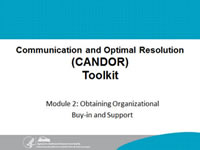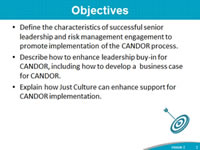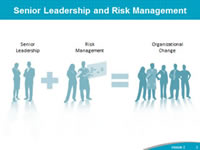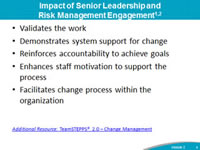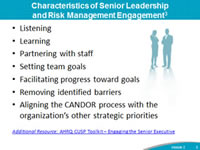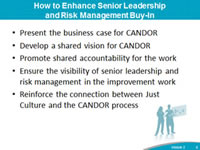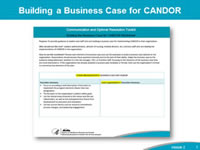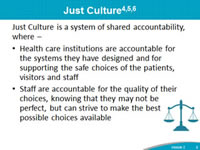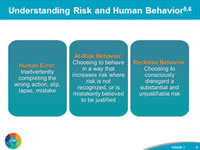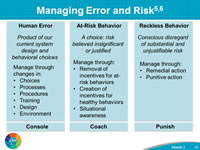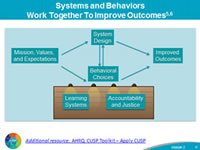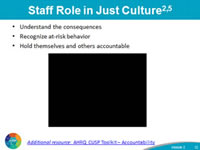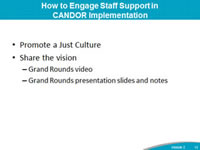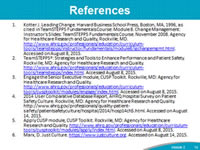Module 2: Obtaining Organizational Buy-in and Support
AHRQ Communication and Optimal Resolution Toolkit
Facilitator Notes
|
Say: Module 2 of the CANDOR Toolkit describes the importance of obtaining organizational support for CANDOR implementation. This module focuses on the role of organizational leaders, risk management, and frontline staff in the implementation of the CANDOR process. To embed the CANDOR process in an organization, all leaders, caregivers, and staff need to be educated on and support the CANDOR process. |
Slide 1
|
|
Say: At the end of this module, the learner will be able to:
Explain how Just Culture can enhance support for the CANDOR process implementation. |
Slide 2
|
|
Say: Successful implementation and sustainment of the CANDOR process requires the entire organization’s input, support, and buy-in. Confirming senior leadership and risk management engagement is an essential first step in building organizational support and buy-in. Senior leadership might include staff with or without clinical backgrounds. Senior leaders may include the Director of Nursing, the Chief Medical Officer, the Chief Executive Officer, or Chief Operating Officer. Members of the senior leadership team understand the organization’s safety culture and its quality improvement and patient safety priorities. Senior leadership support is necessary to implement and sustain change across an organization. The risk managers in health care organizations are responsible for assessing, developing, implementing, and monitoring risk management plans with the goal of minimizing exposure. The CANDOR process directly impacts an organization’s risk management department and its processes. It is vital that senior leadership and risk management leaders work together to implement the CANDOR process and the associated organizational changes necessary to sustain the process over time. Both of these leadership groups must be involved and engaged in the CANDOR process implementation work to achieve the desired goals. |
Slide 3
|
|
Say: Collaboration among senior leadership and risk management in the CANDOR implementation process can help validate the work’s importance. Their collective involvement demonstrates to staff that leaders will support the staff’s efforts to make the necessary changes to improve safety. Senior leadership can also reinforce accountability for implementation of the process and goal achievement. Active engagement and buy-in from leadership across the organization can also enhance staff motivation to support the necessary changes. Buy-in of all leaders can help facilitate the overall change process within the organization. In module 3, we will discuss in greater detail Kotter’s 8-Step Process for Leading Change model. This model describes what must happen to achieve system-wide change; it also reinforces the vital role that senior leaders play in the change process. For more information on the change process, see the Change Management module of the TeamSTEPPS 2.0 Curriculum. |
Slide 4
|
|
Say: Senior leaders and risk managers can demonstrate their engagement in the CANDOR implementation process by: listening, learning, and partnering with staff throughout the implementation phase. If a senior leader or the risk management director are not the designated CANDOR Implementation Team Lead, they can support the CANDOR Implementation Team Lead by helping the team set goals, facilitating progress toward goals, and removing identified barriers to progress. The CANDOR Implementation Team Lead is the senior leader who is responsible for organization-wide implementation of the CANDOR process. Leaders can also demonstrate support and engagement by aligning CANDOR processes with the organization’s other strategic priorities. For more information on characteristics of an engaged senior leader, see the Engaging the Senior Executive module of the AHRQ CUSP Toolkit. |
Slide 5
|
|
Say: Understanding the importance and characteristics of engaged senior leadership and risk management in the implementation of the CANDOR process is only part of the equation. It is also important to understand how to engage senior leaders and risk management. A key strategy to actively engage senior leadership and risk management is to ask the leaders to help develop a shared vision for the CANDOR process implementation at your organization. Including leaders in the development of the vision can build understanding and ownership of the CANDOR process. The CANDOR Implementation Team and Team Lead can also ask the senior leaders and risk management personnel to help define and promote shared accountability for the work of implementing the CANDOR process. The shared accountability discussions will help senior leaders and risk managers answer the question: “What’s in it for me?” It is also important that senior leaders and risk managers be visible to staff throughout the CANDOR implementation process to enhance staff understanding and support for the proposed changes. The next few slides expand on how to develop a business case and use the principles of Just Culture to enhance leadership engagement and support for the CANDOR process. |
Slide 6
|
|
Say: Presenting the business case for the CANDOR process is another strategy to help leaders clearly see the value of a program and how implementation will support the organization’s patient safety and quality goals. Every organization must be able to justify the use of human and material resources needed to implement a new program. Leaders must be able to understand how success (or failure) will be measured to support the people, time, and actions requested to achieve the desired outcomes. The key elements of a business case include all the essential information to help leaders understand how the resources and procedures of the CANDOR process support the organization’s patient safety and quality goals. By helping leaders understand these connections, the leaders are better prepared to commit resources and people and to support successful CANDOR process implementation and sustainment. The Building the Business Case for CANDOR Worksheet can help leaders and teams develop an individualized business case for implementing the CANDOR process in the organization. Helping leaders understand how to connect the CANDOR process with the organization’s safety and quality priorities can enhance their buy-in and support for the CANDOR process implementation. |
Slide 7
|
|
Say: The principles of Just Culture can provide additional support to engage leadership and staff support for the CANDOR process. In hospitals, staff traditionally have felt that their mistakes are held against them and kept in their personnel file, as noted in the results of the AHRQ Hospital Survey on Patient Safety Culture comparative database. In a punitive culture that does not strive to understand potential underlying reasons for behaviors, transparency is impossible. Transparency is also vital in addressing system factors that may contribute to harm. To develop and sustain a culture that promotes candid, caring communication and timely resolution of harmful events with patient and families, employees of the health care system must be supported in a fair, just, and caring culture that promotes transparency. Therefore, promoting a culture that is fair and just is an underlying value needed to promote CANDOR culture. David Marx’s Just Culture model refers to a system of shared accountability in which health care institutions are accountable for the practices they have designed and for sustaining the safe choices they have made regarding patients, visitors, and staff. Staff, in turn, are accountable for the quality of the choices they make to ensure their patients receive the highest quality of care possible. |
Slide 8
|
|
Say: The concept of Just Culture gives a framework for understanding risk and human behavior. A continuum of possible attitudes and behaviors related to risk is described in three categories:
Reckless behavior—Choosing to consciously disregard a substantial and unjustifiable risk. |
Slide 9
|
|
Say: To improve outcomes, human error, at-risk behavior, and reckless behavior should each be managed appropriately.
Reckless behavior is a conscious disregard of substantial and unjustifiable risk. When reckless behavior has occurred, it must be met with remedial or punitive action to decrease or eliminate the chances the behavior will reoccur. |
Slide 10
|
|
Say: Within the Just Culture model, five elements contribute to improved outcomes. These are:
Mission, values, and expectations—For an organization to effectively fulfill its purpose, it must first define its mission and articulate values and expectations that align with that mission. Perfection is not a productive expectation because it is unattainable. Rather, an organization should set improvement as a goal. System design—Humans are fallible and occasionally make mistakes, either through inadvertent errors or risky behaviors. To achieve optimal outcomes, organizations must design robust systems that minimize risks. Forcing functions, checks, and redundancies are some features of systems intended to minimize the risk of error. Behavioral choices—Managing human behavior is essential to refining outcomes. It is critical to reinforce behaviors that will reduce risk and deter behaviors that increase risk. Learning systems—By establishing learning systems, organizations can manage both systems and human behavior. Accountability and justice—Accountability in a Just Culture environment is about more than simply blaming a person whenever a patient is harmed. In a Just Culture environment, the quality of behavioral choices should be emphasized more than the outcome of the choices, which may or may not have resulted in harm. Organizations that strive to establish a culture of safety should support the five elements of a Just Culture to promote candid, caring communications and timely resolution of harmful events. For more information on Just Culture, see the Apply CUSP module of the AHRQ CUSP Toolkit. |
Slide 11
|
|
Say: Individual staff also have an important role in applying Just Culture principles. Individual staff must recognize when they are engaging in at-risk behavior and how their behavior might cause unjustifiable harm to patients. More importantly, staff must hold themselves and others accountable for making appropriate choices. This accountability is best demonstrated through peer-to-peer coaching, which is one of the hallmarks of a Just Culture and TeamSTEPPS. Let’s watch this video which demonstrates peer-to-peer coaching and accountability. Do: Ask: Think about the behavior exhibited by the two colleagues. How does it support accountability in a Just Culture? How does the behavior of staff support a culture of safety? Say: For more information on this video, and to see a debrief on accountability, see the AHRQ CUSP Toolkit and the linked video. In the next module, we will discuss assessment of organizational readiness for change, which is the next step in building the infrastructure to implement the CANDOR process. |
Slide 12
|
|
Say: By supporting a just culture, where staff do not fear a punitive response to errors and reporting, leaders build staff support for CANDOR process implementation. Understanding the CANDOR process is important in engaging staff in CANDOR process implementation. The Grand Rounds presentation materials are designed to introduce the CANDOR process to the organization. The organization can request that staff watch the Grand Rounds video or use the presentation slides and notes to personalize a presentation to a particular team. In the next module, we will discuss assessment of organizational readiness for change, which is the next step in building the infrastructure to implement the CANDOR process. |
Slide 13
|
|
|
Slide 14
|




